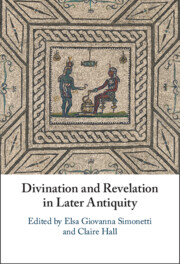Book contents
- Divination and Revelation in Later Antiquity
- Divination and Revelation in Later Antiquity
- Copyright page
- Contents
- Illustrations
- Notes on Contributors
- Acknowledgements
- Introduction
- Part I Philosophical Perspectives on Divination, Revelation, and Prophecy
- Part II Status, Role, and Functions of Human Intermediaries
- Part III Divine Transcendence and Pragmatic Purposes
- Chapter 9 Revelation and Roman Augury
- Chapter 10 ‘For Thy Kingdom Is Past Not Away, / Nor Thy Power from the Place Thereof Hurled’
- Chapter 11 ‘No Longer Does Phoebus Have a Cabin’
- Index
- References
Chapter 10 - ‘For Thy Kingdom Is Past Not Away, / Nor Thy Power from the Place Thereof Hurled’
Martianus Capella and a Prophylactic Oracle of Apollo
from Part III - Divine Transcendence and Pragmatic Purposes
Published online by Cambridge University Press: 19 October 2023
- Divination and Revelation in Later Antiquity
- Divination and Revelation in Later Antiquity
- Copyright page
- Contents
- Illustrations
- Notes on Contributors
- Acknowledgements
- Introduction
- Part I Philosophical Perspectives on Divination, Revelation, and Prophecy
- Part II Status, Role, and Functions of Human Intermediaries
- Part III Divine Transcendence and Pragmatic Purposes
- Chapter 9 Revelation and Roman Augury
- Chapter 10 ‘For Thy Kingdom Is Past Not Away, / Nor Thy Power from the Place Thereof Hurled’
- Chapter 11 ‘No Longer Does Phoebus Have a Cabin’
- Index
- References
Summary
The chapter provides a reconsideration of a section in Martianus Capella’s Book 1, dedicated to the ‘failure of the oracles’ and culminating in a quotation of a prophylactic Apollinean oracle, attributed to Alexander of Abonouteichos. The author tries to reconstruct some possible lines of transmission of this oracle, at the same time highlighting how its allegorical framework helps to shed light on some aspects of the ongoing controversy between pagans and Christians, which took into account the thaumaturgical and therapeutic capabilities of the gods.
- Type
- Chapter
- Information
- Divination and Revelation in Later Antiquity , pp. 191 - 207Publisher: Cambridge University PressPrint publication year: 2023



